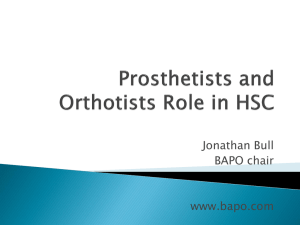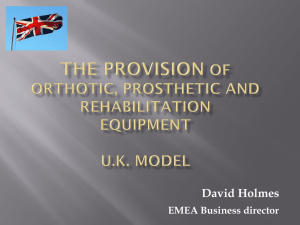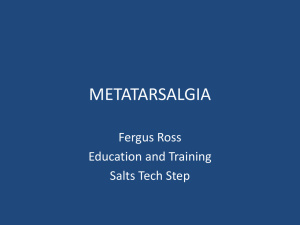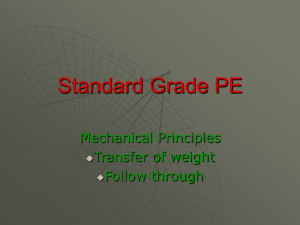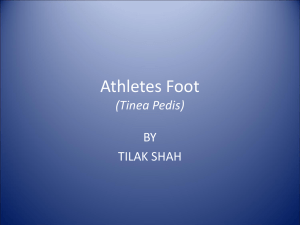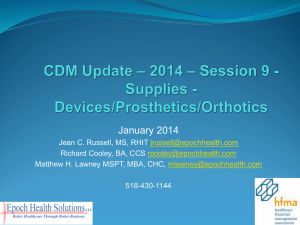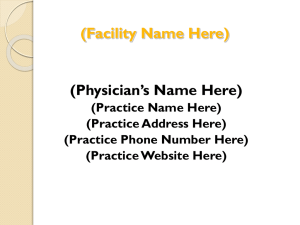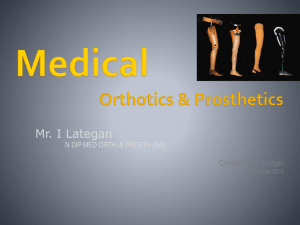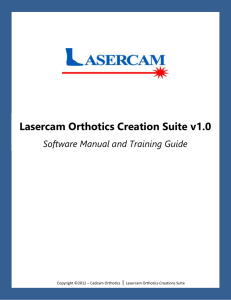The foot has three arches, the medial longitudinal arch, the lateral
advertisement
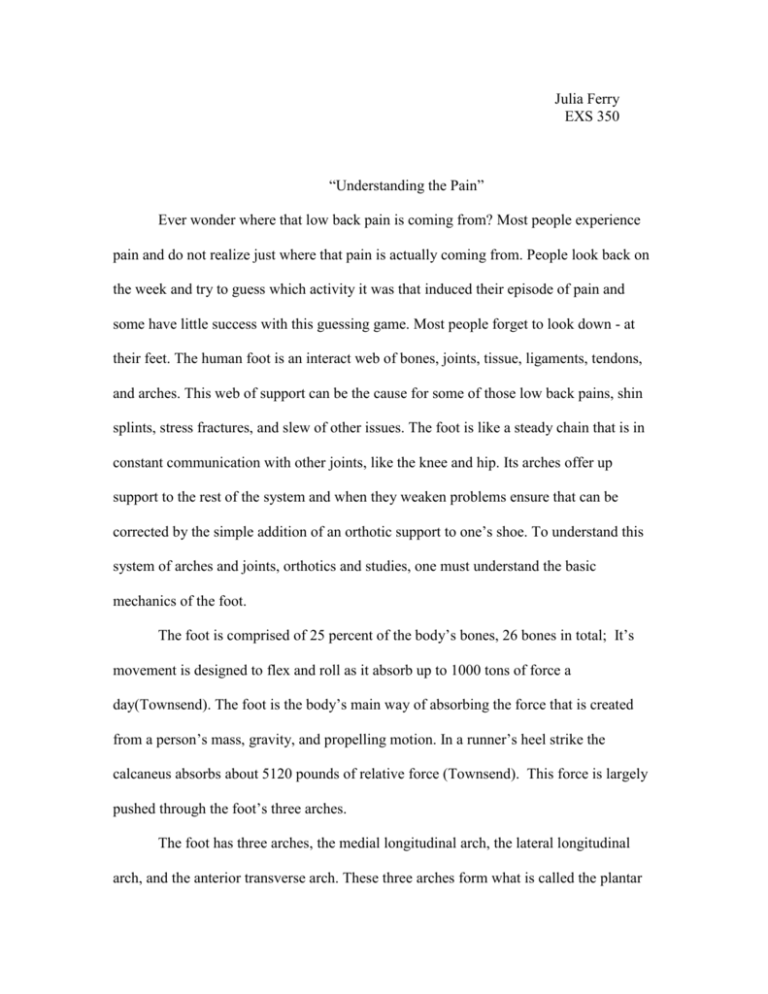
Julia Ferry EXS 350 “Understanding the Pain” Ever wonder where that low back pain is coming from? Most people experience pain and do not realize just where that pain is actually coming from. People look back on the week and try to guess which activity it was that induced their episode of pain and some have little success with this guessing game. Most people forget to look down - at their feet. The human foot is an interact web of bones, joints, tissue, ligaments, tendons, and arches. This web of support can be the cause for some of those low back pains, shin splints, stress fractures, and slew of other issues. The foot is like a steady chain that is in constant communication with other joints, like the knee and hip. Its arches offer up support to the rest of the system and when they weaken problems ensure that can be corrected by the simple addition of an orthotic support to one’s shoe. To understand this system of arches and joints, orthotics and studies, one must understand the basic mechanics of the foot. The foot is comprised of 25 percent of the body’s bones, 26 bones in total; It’s movement is designed to flex and roll as it absorb up to 1000 tons of force a day(Townsend). The foot is the body’s main way of absorbing the force that is created from a person’s mass, gravity, and propelling motion. In a runner’s heel strike the calcaneus absorbs about 5120 pounds of relative force (Townsend). This force is largely pushed through the foot’s three arches. The foot has three arches, the medial longitudinal arch, the lateral longitudinal arch, and the anterior transverse arch. These three arches form what is called the plantar volt. One is not born with the plantar volt but it is developed around the age of six in most children (Danchik). Each arch is situated in the foot specifically to help elevate the body’s load. The medial longitudinal arch is the arch that is most visible in the foot, located on the medial aspect. This arch consists of the navicular bone and is supported mainly by the planter fascia and the spring ligament. On the opposite side of the foot is the lateral longitudinal arch; this arch is mainly supported by the cuboid bone. The lateral longitudinal arch is usually left out from many of the orthotic support but it is equally as important as the other two arches in the plantar volt. The third arch that makes up the plantar volt runs from the medial to lateral side of the foot. Because the anterior transverse arch runs from the metatarsal heads back to the tarsal bones, when it weakens there is often a build up of callous material under the metatarsal heads (Danclik). The repeated falling of the arch or a disturbance of the interdigital nerves could indicate that the arch is not getting support from the plantar fascia. When the plantar volt lacks it’s needed support problems can then radiate up the body, effecting the knees, spine, or hips. This occurs because approximately 50 to 60 percent of the body’s weight is supported by the plantar volt and with out the volt’s proper support the forces can be abnormally concentrated and cause problems throughout the body (Danclik). This degeneration of the plantar vault can cause clinical symptoms. A typical way to correct this issue is to prescribe custom orthotics to the symptomatic patient. The orthotics act as a support to the three arches so that during normal standing the main force of the load, situated at the plantar volt apex, is fully supported. This way, throughout a normal gait cycle the impact forces will be controlled (Danclik). 2 But what is a normal gait cycle? The average walking gait consists of an alternating stance and swing of each leg; while the right leg is in swing the left leg is in stance and vice versa. In a normal gate the stance phase is about 62 percent while the swing phase only occurs 38 percent of the time (class notes). Each of these two phases can be broken down further. The stance phase has five parts to it, the heel strike, foot flat, heel rise, push-off, and toe-off (class notes). During the push-off and toe-off stage the foot experiences the largest force, at nearly five times the body’s weight (class notes). This force is placed on non locked joints (from the pelvis down through the knee) and even the slightest sway of movement can disrupt the body’s natural alignment. This is why it is imperative that the body be properly supported, starting at the feet. Any instability from the feet can result in any number of problems along the legs, knees, hips, or even spine of the body. Throughout normal gait, the body’s joints are inter-connected; one joint’s movements effect the next joint’s movements (Danclik). With a normal force loading stance the feet evert slightly to an average of 30 degrees, and a plumb line is lowered from the sacral promontory whose line is between the navicular bones of the feet (Danclik). As the foot pronates the medial longitudinal arch is jeopardized and may result in a collapsing of this arch (Danclik). Once the medial longitudinal arch is deteriorated the foot’s vaulted arch stability is lost and clinical symptoms will rise up along the leg, manifesting as things like – shin splints, gastructnemious cramps, plantar fascitis, heel spurs, or stress fractures (Danclik). This upward traveling manifestation does not stop there; depending on how much pronation has occurred the effects may travel further up. The femor may be affected, and 3 thus bringing the greater trocantor forward and out. The muscle at the greater trocantor, the piriformus, will result in a stretch that affects it’s attachment points in the sacrum. The inflicted side may be affected by subluxated anterior, inferior position because of the stretch put on the piriformus (Danclik). Due to this subluxation, the glutious maximus moves to compensate and thus a further chain of afflictions will begin. Flat feet do not just manifest from an over load of stress to the foot and it’s vaulted arch, but can be due to a lack of development. This lack of development occurs when the large medial fat pad does not decrease into the medial longitudinal arch (Danclik). This developed flat foot can be classified as either ridged or flexible. A flexible foot can be determined by observing the foot while in a non weight bearing seated position. If the foot holds an arch while in a non weight bearing position or while on the toes then it is considered to be flexible and treatable with arch supports (Danclik). But if the foot remains observably flat then the foot is considered ridged and the patient must seek a specialist’s help. These conditions are, however, rare with only 28 to 35 percent of all school children diagnosed with such a problem and 90 percent of those will still develop an arch before they turn ten years old (Danclik). No matter how rare this problem is it is still an issue that afflicts many Americans and must be treated to help prevent the chain of problems that may result from the structure abnormality. The structured support that orthotics offer will help discourage pronation and encourage normal function of the foot and ankle (Danclik). By maintaining normal weight, increasing muscle strength and flexibility, along with the addition of custom orthotics, the patient should be able to correct the problem before it becomes irreversible. The most important part is gaining custom orthotics. 4 Orthotics is not just a funny word, it is a very useful device that helps stabilize the foot and offers a good base of support for the body. There are three basic types of ortontics; those that are functional, protective, and a mix of both function and protection. Each different type serves the wearer in a different way. Functional orthotics are made out of a rigid material, typically plastic or carbon fiber. These types of orthotics are normally used for walking or dress shoes and control motion of the foot in two major foot joints. While protective orthotics are typically a softer material so that they can absorb the loads put on the foot. By absorbing the loads placed on the foot it can increase stabilization and take the pressure off uncomfortable or sore spots of the feet. This type of orthotic rests against the sole of the foot and extends from the heel past the ball of the foot. The third option of orthotics lies someplace in-between with a soft surface reinforced with a ridged support. This type of orthotic offers both functional support and protection. It is this third type that is often prescribed to athletic patients and can vary between sports; they are often used to mitigate pain while the athlete practices or competes. In the case of all three, the orthotics must be customized to support the wearer’s particular deformity. The customization of orthotics will vary between orthotic companies. However, they will all make some sort of cast of the weight bearing patient’s feet. The casting is typically done in the podiatrist’s office and is sent out to the orthotic maker. The cast is then utilized when the company produces the patient’s chosen type of orthotic; to craft the orthotic the casting creates a three dimensional image of the foot. From this image the company then makes an orthotic that will help support the weakened areas and assist the 5 foot in each step. This individualized orthotic is then sent back to the doctor’s office. Some insurance companies will cover the expense of these custom shoe inserts while others do not yet understand the research that supports the use of orthotics. There has been extensive data collected on the effectiveness of these prescribed orthotics. One such study was conducted in 1988 in which 20 subjects with flatfeet were observed for their oxygen consumptions pre and post orthotics (Danclik). The participants were put on a tredmill and observed walking with out orthotics and then with. Their medical history was taken also and besides flat feet they were not symptomatic. The results indicated that when the participants used orthotics their gait efficacy rose and oxygen consumption decreased (Danclik). This study is only one in several that supports the use of orthotics in gait stability. Another study observed the use of orthotics in 40 participants who all had bilateral hyperpronation. Bilateral hyperpronation can cause any number of issues with the lower extremities and tissues. One known issue it causes is a change in the quadriceps femoris angle (Q- angle). The Q-angle is known as the angle at which the anterior superior iliac spine (ASIS) connects with the center of the patella and where the line of the tibial tubarsity connects with the patella center. This angle has been associated with patella abnormalities, including patellar displacement. The study selected 40 male participants from the Logan College of Chiropractic and the Montgomery Health Center (Kuhn). To determine if the participants were, infact, bilateral pronators their gait was observed for any external rotation or toe-outing during the planting phase of gate. Then the researchers examined the participants’ shoes 6 for lateral wear. Lastly the participants’ Achilles tendons and the length of their medial arches were noted. Casting of the participants feet were made by the Foot Levelers casting kit and full length flexible orthotics were made. The participants’ Q-angles were measured while they were in a standard knee extended position and in their normal footwear. The angle itself was measured using a 12 inch goniometer with a 24 inch arm. Only one person conducted measurements and that examiner did not know if the participant was wearing orthotics or not. The average measured Q-angle on the left was 12.1 degrees with a standard deviation of 2.6 degrees, while it was 11.8 degrees on the right with a standard deviation of 2.2 degrees (Kuhn). While this study does not have as large of subject pool as desired it does have significant results. With out orthotics the participants had a mean 2.3 degree asymmetry; after orthotics were inserted the population had a mean 1.4 degree asymmetry (Kuhn). This indicates a 0.9 degree decrease in the Q-angle’s asymmetry(Kuhn). It was also indicated that when the initial difference was larger the decrease in Q-angle asymmetry was also larger. This is a great study when examining the usefulness of orthotics. Many other studies have been done to indicate the need for orthotic support. Most studies show minimal benefit at the very least, with most indicating much more significant findings. A much larger study conducted by Karl B. Landorf of La Trobe University was conducted and found little to support the use of custom orthotics over sham orthotics in the treatment of planter fasciatis. Planter fasciatis is a inflammation of the planter fascia. It is believed that the radiating pain from the heel to the toes is from repeated partial tearing of the enthesis and 7 chronic inflammation that occurs (Stuber). This inflammation and painful clinical symptom is often treated by use of orthotics because it is believed that this injury is due to improper foot biomechanics. The Landorf study tests the treatement of planter fasciatis with orthotics by introducing the subjects to either custom orthotics, over the counter orthotics, or shame (fake) orthotics. The three types of orthotics the Landorf study used were randomly assigned to the 135 participants. These participants, mostly female, were given one of the three orthotics and then observed at three and twelve months. When observed at the three month period the participants who wore prefabricated (over the counter) or custom orthotics showed improvement only in their function compared to those who wore fake orthotics. Pain levels in both groups were equal at both the three and twelve month examination (Napoli). However, function at the twelve month examination was also equal in both subject groups (Napoli). This study, while important, does not attest or disprove the usefulness of orthotics in increasing support to an abnormally functioning foot. Feet that have arch abnormalities are obviously in need of additional assistance in supporting the forces that the foot needs to absorb in a day. Many people with such arch instabilities have radiating problems that affect not only their lower legs but all the way up to their knees, hips, and spine. Understanding the mechanics of the foot, the arches and chain of joints, the orthotics and studies, will help the chronic low back pain sufferer realize the actual cause of that stiffness is in the feet. 8
